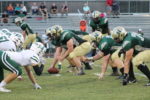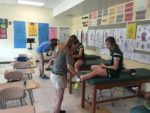Oct. 12, the Orange vs. Hillside junior varsity football game is drawing to a close, with tensions high and stands brimming. Midway through the next play, freshman Thys Oldenburg is roughly tackled to the ground. In the fall, he endures severe head trauma and has to be carried from the field.
When the scope of Oldenburg’s injuries became clear, he was immediately rushed to the hospital where they could be further assessed. At Duke, three emergency cranial surgeries were performed within the first 24 hours. Shortly after, Oldenburg was placed into a medically induced coma as a part of the continuing effort to reduce the swelling on his brain. He remained in that coma for over six weeks, missing visits from his family, from his girlfriend, the rest of the football season and what would’ve been his first high school dance.
Though Oldenburg’s family wished to retain some privacy during his stint in critical care, they always said his condition was “steadily improving.” Due to the encouraging results of a CAT scan, they always expected he’d regain consciousness before long. Then, in late November, he did.
Orange’s next game after Thys’ injury was at Northwood. To help raise money, orange towels were sold, branded with the Oldenburg’s number 22 above a pair of hands clasped in prayer. The towels sold out within the first 30 minutes, with all proceeds going toward Oldenburg’s medical bills.
The towels were donated by Robyn Allgood, owner of M2 graphics, a Pittsboro-based printing company.
“I couldn’t imagine what that family was going through,” Allgood said.
Being a mother herself, she said that the situation must have been “devastating,” and that she just wanted to “do whatever [she] could to help.”
Allgood’s charitable efforts were not alone. Oldenburg’s aunt, Caroline, started a GoFundMe page. It has, thus far, raised almost $30,000 of its $100,000 goal. Caroline Oldenburg said that if her nephew makes a speedy recovery, any remaining money would carry over for “the next kid who this happens to.”
But will there be a next kid? The recent slew of high school football injuries left many parents on edge, wondering if their teens were safe behind their helmets.
Back at Northwood, football coach Brian Harrington shared his thoughts on the danger of the game.
“Right now, all football coaches do everything they can, safety-wise,” Harrington said.
They try to teach the safest playing strategies and keep the head out of the tackle.
“With that being said, it is still a contact sport,” Harrington said. “Kids get hurt. That’s why we wear helmets.”
The helmets themselves are becoming safer as well. In recent years, the Northwood athletics department has installed sensors to measure how hard players collide.
“The impact sensors we put in the helmets will hopefully gather enough data to help with injury prevention in the future,” Harrington said. “If not in the prevention, maybe the reduction.”
It’s undeniable that playing football is associated with certain hazards, but Harrington believes the reward outweighs them all.
“The risk isn’t that high, and the reward is through the roof,” Harrington said. “If I really, truly believed that it wasn’t worth it, my son wouldn’t be playing.”
Harrington goes so far as to call football the “ultimate team sport,”`
Harrington says his players “learn the true value of teamwork and camaraderie” during their time on the field, “preparing them” for adulthood and professionalism in a way school is unable to. Though such benefits go hand-in-hand with serious risks, they are ones that he and his players have accepted.
– By Chase Miller


